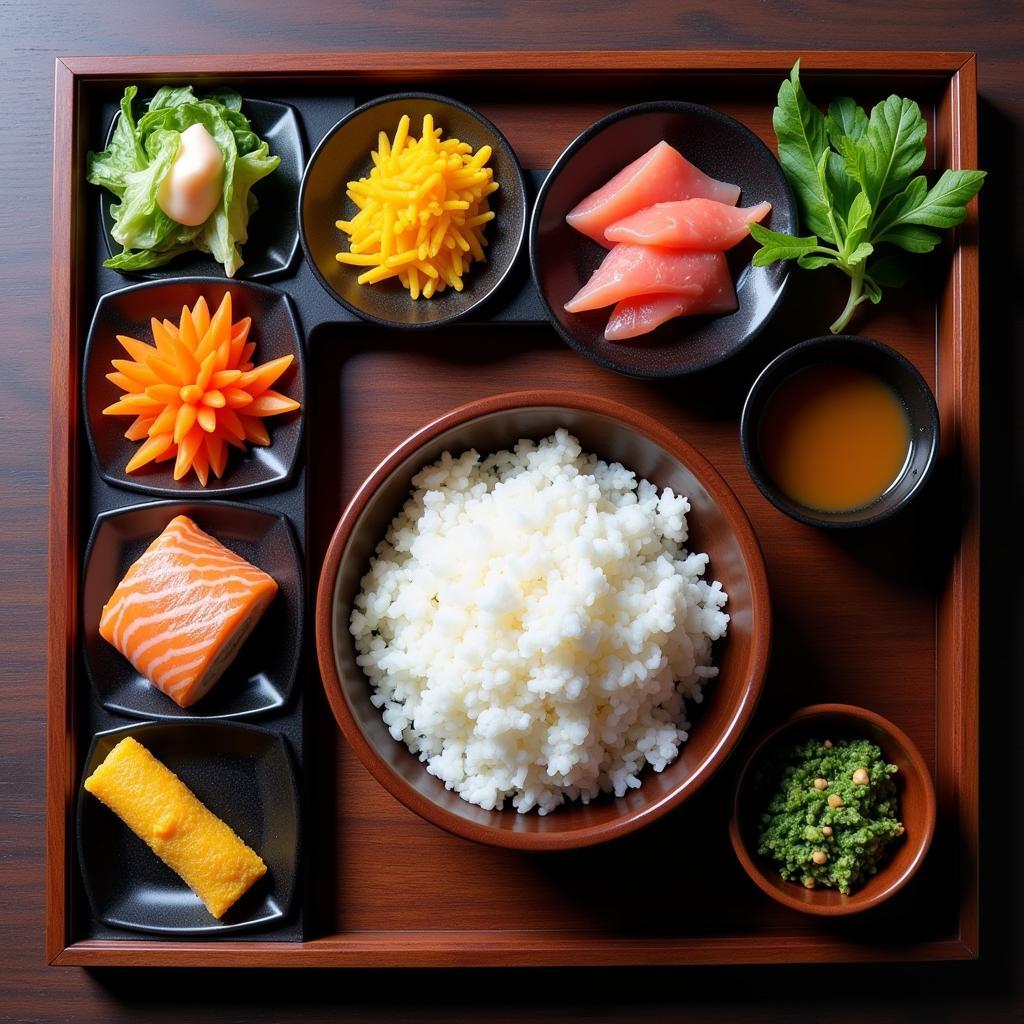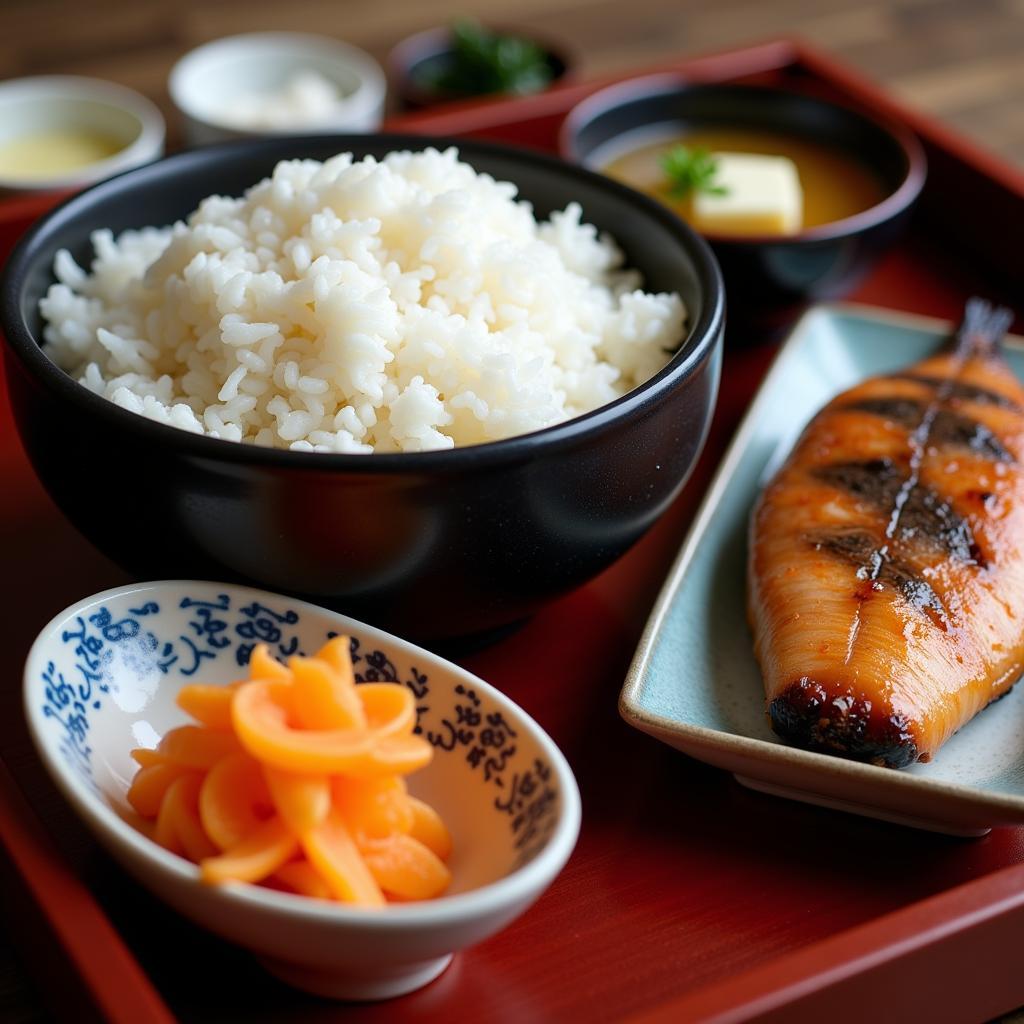The Japanese Food Tray, or teishoku, is more than just a meal; it’s a culinary art form. It’s a carefully curated collection of flavors, textures, and colors, presented in a visually stunning arrangement. From the vibrant hues of pickled vegetables to the glistening glaze on grilled fish, every element of a Japanese food tray tells a story. This article dives into the fascinating world of Japanese food trays, exploring their history, components, and cultural significance. You can easily find a lunch tray with food in many Japanese restaurants.
Decoding the Teishoku: A History and Overview of the Japanese Food Tray
The teishoku originated during the Meiji period (1868-1912) as a quick and affordable meal option for workers. Initially simple, it evolved over time, incorporating influences from both traditional Japanese cuisine and Western dining practices. Today, the Japanese food tray remains a staple in homes and restaurants across Japan, offering a balanced and satisfying meal experience. It’s a testament to the Japanese philosophy of washoku, which emphasizes harmony and balance in food, both nutritionally and aesthetically. Let’s delve into what makes the Japanese food tray so special.
Have you ever wondered what goes into creating a perfectly balanced Japanese food tray?
A typical teishoku includes a main dish, rice, miso soup, pickled vegetables (tsukemono), and a small side dish. The main dish can vary widely, from grilled fish or chicken to tempura or tonkatsu. The emphasis is on variety and balance, ensuring a harmonious blend of flavors and textures.
After this brief history, let’s explore the art of assembling a beautiful and delicious Japanese food tray.
 A Vibrant Teishoku Displaying a Variety of Japanese Dishes
A Vibrant Teishoku Displaying a Variety of Japanese Dishes
Essential Components of a Japanese Food Tray
What are the key components that make up a traditional Japanese food tray?
The heart of any Japanese food tray is the rice. It is the foundation upon which the other elements are built. Accompanying the rice is almost always a bowl of miso soup, providing a warm and comforting counterpoint to the other flavors. The tsukemono, or pickled vegetables, add a sharp, tangy note, cleansing the palate and aiding digestion. These are often brightly colored, adding visual appeal to the tray.
Beyond these staples, the variety in main dishes and side dishes is what truly sets the teishoku apart. From the crispy crunch of tempura to the succulent sweetness of teriyaki chicken, the options are endless.
Perhaps you’re considering purchasing some safety shoes for food industry workers.
 Essential Elements of a Traditional Teishoku
Essential Elements of a Traditional Teishoku
The Cultural Significance of the Japanese Food Tray
The Japanese food tray is more than just a meal; it reflects deeply ingrained cultural values. It embodies the principles of washoku, emphasizing the balance of flavors, textures, and colors, as well as the importance of seasonal ingredients. It’s a testament to the Japanese appreciation for aesthetics and mindfulness in dining. The teishoku also speaks to the Japanese value of efficiency and practicality, providing a complete and satisfying meal in a compact and manageable format.
Why is presentation so important in Japanese cuisine, particularly with the teishoku?
The visual presentation of the teishoku is as important as the taste. Each dish is carefully arranged on the tray, creating a miniature culinary landscape. The colors, shapes, and textures are all considered, creating a harmonious and visually appealing presentation. This attention to detail reflects the Japanese respect for food and the dining experience.
Thinking about fun activities? Try some junk food trivia questions and answers with your friends.
Conclusion: Experiencing the Japanese Food Tray
The Japanese food tray, with its carefully curated components and emphasis on balance and presentation, is a true reflection of Japanese culinary culture. From its humble beginnings as a worker’s lunch to its current status as a beloved culinary art form, the teishoku offers a unique and satisfying dining experience. So, next time you’re looking for a balanced and delicious meal, consider exploring the art of the Japanese food tray. You might be surprised at the depth of flavor and cultural significance you discover. Perhaps you’ll even find yourself needing some food rollers for your next culinary adventure!
FAQ
-
What is a teishoku? A teishoku is a traditional Japanese set meal consisting of a main dish, rice, miso soup, pickled vegetables, and a small side dish.
-
Where can I find a teishoku? Teishoku are commonly served in Japanese restaurants and are also a popular home-cooked meal.
-
What are the benefits of eating a teishoku? Teishoku offer a balanced and nutritious meal with a variety of flavors and textures.
-
Are teishoku expensive? Teishoku can range in price depending on the ingredients and restaurant, but they are generally an affordable meal option.
-
Can I customize a teishoku? Some restaurants allow for customization, but traditionally, the teishoku is a set meal with pre-determined components.
-
What is washoku? Washoku is traditional Japanese cuisine, emphasizing harmony and balance in food.
-
What is the significance of presentation in a teishoku? The presentation reflects the Japanese respect for food and enhances the dining experience.
For further assistance, please contact us at Phone: 02437655121, Email: [email protected], or visit our address: 3PGH+8R9, ĐT70A, thôn Trung, Bắc Từ Liêm, Hà Nội, Việt Nam. Our customer service team is available 24/7.